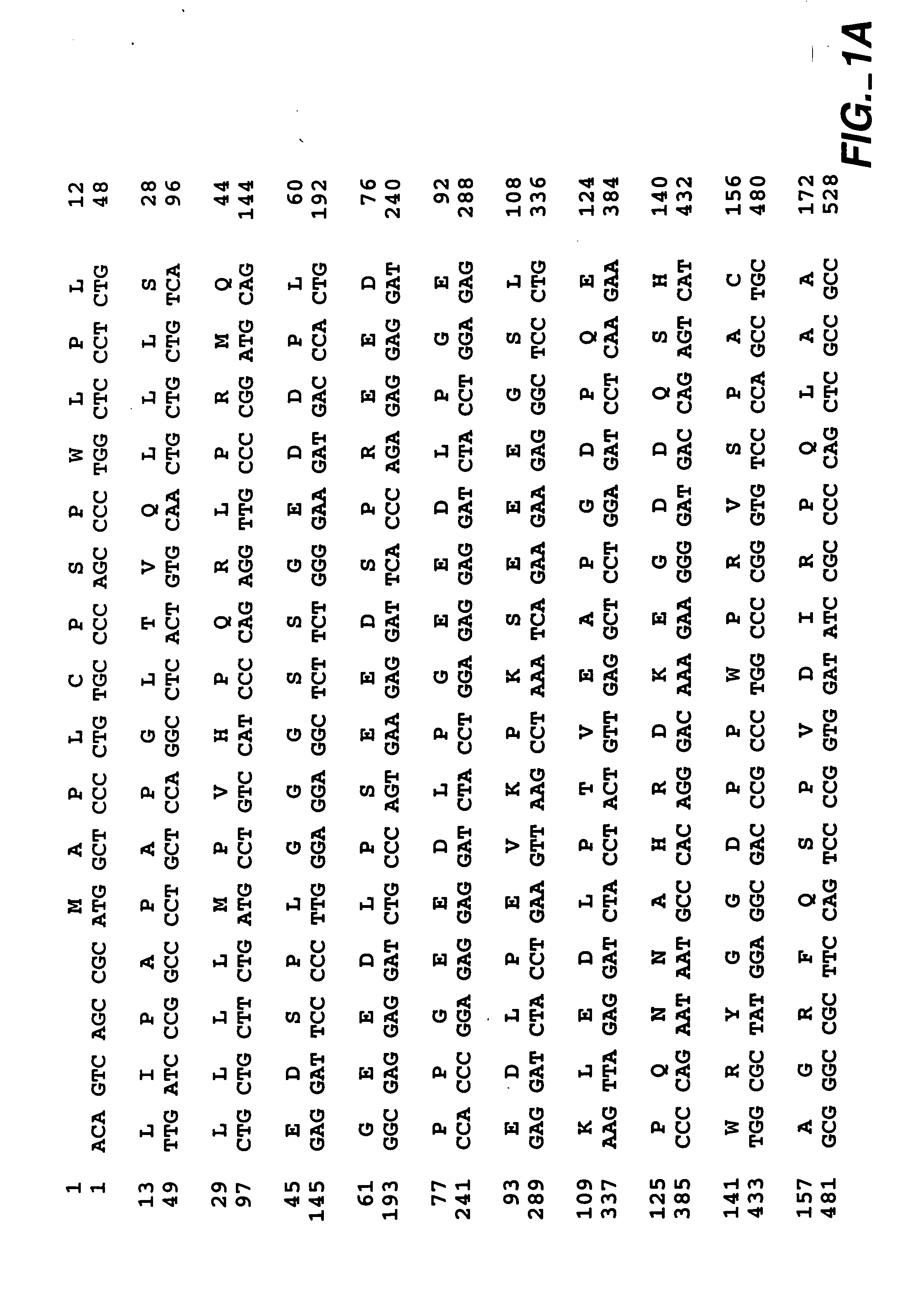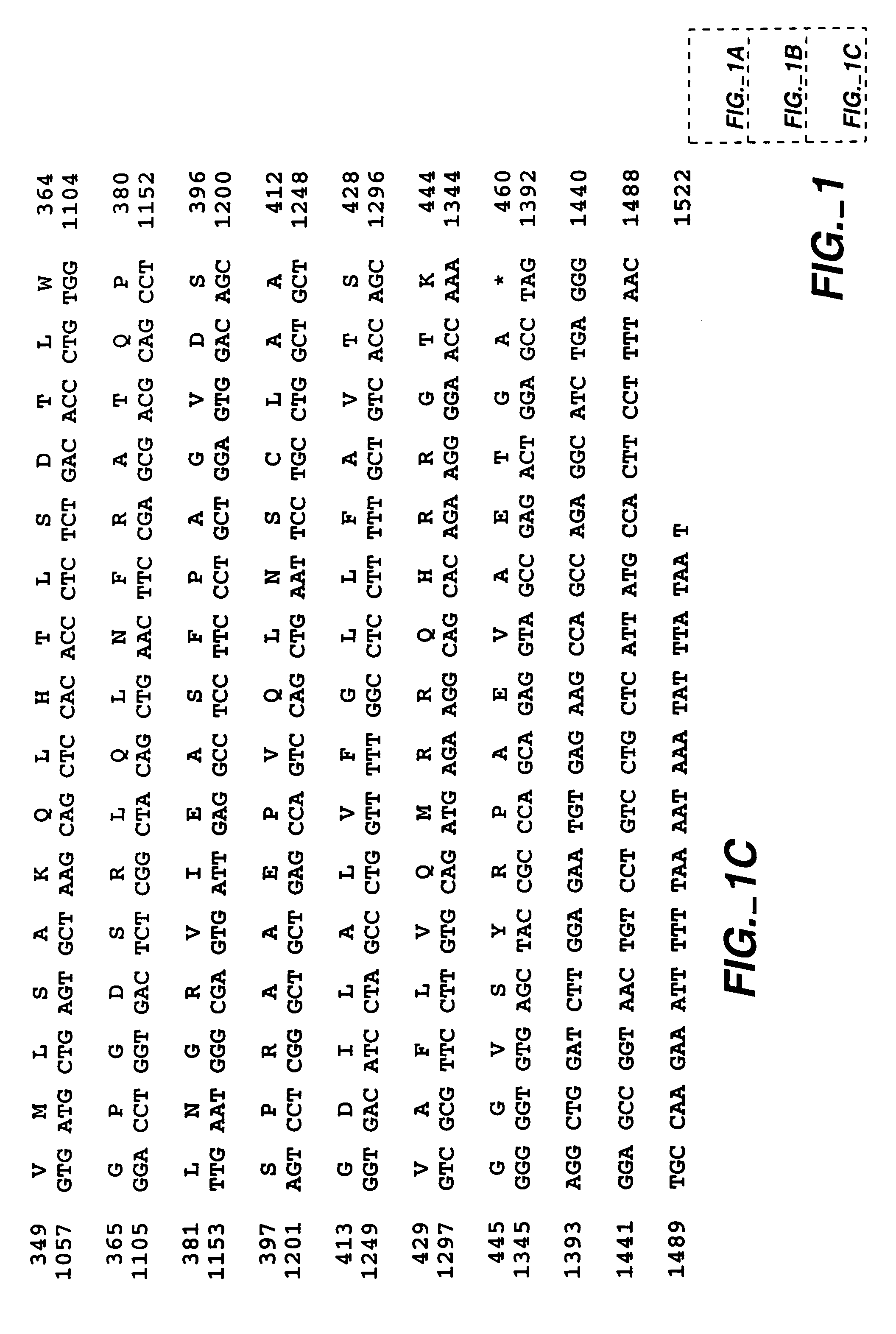MN gene and protein
- Summary
- Abstract
- Description
- Claims
- Application Information
AI Technical Summary
Benefits of technology
Problems solved by technology
Method used
Image
Examples
example 1
Transient Transformation of Mammalian Cells by MN Protein
[0460] This example (1) examines the biological consequences of transfecting human or mouse cells with MN-cDNA inserted into expression vectors, mainly from the viewpoint of the involvement of MN protein in oncogenesis; (2) determines if MN protein exerts carbonic anhydrase activity, and whether such activity is relevant for morphologic transformation of cells; and (3) tests whether MN protein is a cell adhesion molecule (CAM).
Synopsis
[0461] Methods: MN-cDNA was inserted into 3 expression vectors and was used for transfecting human or mouse cells. MN protein was detected by Western blotting, radioimmunoassay or immunoperoxidase staining; in all tests the MN-specific monoclonal antibody M75 (MAb M75) was used. Carbonic anhydrase activity was determined by the acidification velocity of carbonate buffer in C02 atmosphere.
[0462] Results: (1) Cells (human CGL-1 and mouse NIH3T3 cells) transfected with MN-cDNA showed morphologi...
example 2
Identification of MN's Binding Site
[0491] MN protein is a tumor-associated cell adhesion molecule (CAM). To identify its binding site, a series of overlapping oligopeptides, spanning the N-terminal domain of the MN protein were synthesized. The N-terminal domain is homologous to that of proteoglycans and contains a tandem repeat of six amino acids.
[0492] The series of oligopeptides were tested by the cell adhesion assay procedure essentially as described above in Example 1. The synthetic oligopeptides were immobilized on hydrophobic plastic surfaces to see if they would mediate the attachment, spreading and growth of cells. Also investigated were whether the oligopeptides or antibodies inhibited attachment of cells (NIH3T3, HeLa and CGL1) to purified MN protein coated onto such plastic surfaces. The MN protein was affinity purified on agarose covalently linked to sulfonamide, as the MN protein encompasses a CA domain.
[0493] Several of the oligopeptides were found to be biological...
example 3
Identification of Peptides Binding to MN Protein Using Phage Display
[0520] (a) To identify peptides that are recognized by MN protein, a heptapeptide phage display library [Ph.D.®-7 Peptide 7-mer Library Kit (phage display peptide library kit); New England Biolabs; Beverly, MA (USA)] was screened. In screening the library, a selection process, i.e., biopanning [Parmley and Smith, Gene, 73: 308 (1988); Noren, C. J., NEB Transcript. 8(1): 1 (1996)] was carried out by incubating the phages encoding the peptides with a plate coated with MN protein, washing away the unbound phage, eluting and amplifying the specifically bound phage.
[0521] The target MN protein in this process was a glutathione-S-transferase (GST) MN fusion protein (GST-MN). GST-MN is a recombinantly produced fusion protein expressed from pGEX-3X-MN containing the cDNA for the MN protein without the signal peptide. GST-MN was produced in bacteria under modified cultivation conditions (decreased optical density, decrease...
PUM
| Property | Measurement | Unit |
|---|---|---|
| Fraction | aaaaa | aaaaa |
| Flexibility | aaaaa | aaaaa |
| Therapeutic | aaaaa | aaaaa |
Abstract
Description
Claims
Application Information
 Login to View More
Login to View More - R&D
- Intellectual Property
- Life Sciences
- Materials
- Tech Scout
- Unparalleled Data Quality
- Higher Quality Content
- 60% Fewer Hallucinations
Browse by: Latest US Patents, China's latest patents, Technical Efficacy Thesaurus, Application Domain, Technology Topic, Popular Technical Reports.
© 2025 PatSnap. All rights reserved.Legal|Privacy policy|Modern Slavery Act Transparency Statement|Sitemap|About US| Contact US: help@patsnap.com



